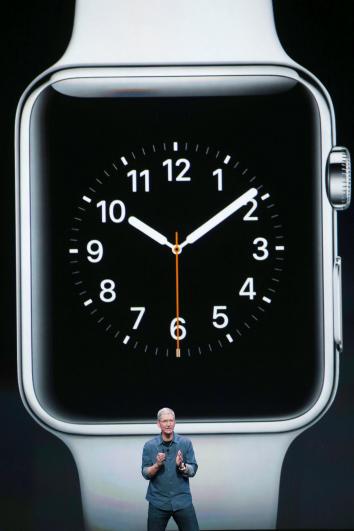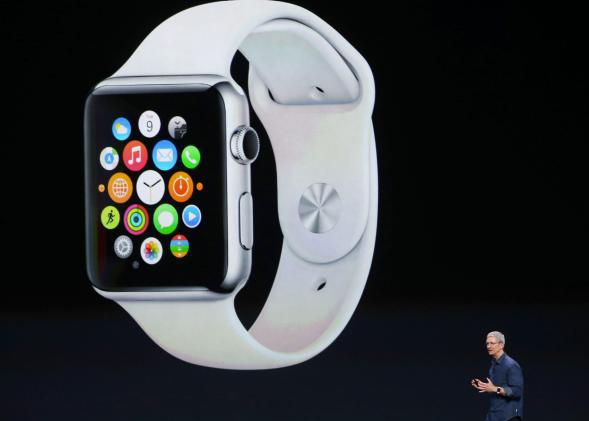For the first time in Tim Cook’s tenure as CEO, Apple has surpassed expectations for a new product.
Before Tuesday, most of the chatter about Apple’s fall gadget launch revolved around the company’s forthcoming phones, the iPhone 6 and the iPhone 6 Plus. Those, it turned out, were not the stars of the show. Instead, techies will remember Sept. 9, 2014 as the day Apple launched the Apple Watch.
We knew a watch was probably coming. What we didn’t know was whether it would be any good. Really, we still don’t, since it won’t be released until early next year. That said, it looks good. Like, really good. And if its functionality lives up to its billing, it could be the thing that gets us all to start checking our wrists again.
And if the $349 Apple Watch’s functionality doesn’t live up to its billing? It might still be the thing that gets us all to start checking our wrists again. It’s that snazzy.
Its promise is threefold:
- It aims to be a lightweight complement to your iPhone, allowing you to send and receive texts, get calendar alerts, check the weather, or find the nearest Starbucks without taking out your phone. Assuming Apple Pay catches on, you’ll also be able to use it to pay for your groceries.
- It doubles as fitness and health tracker.
- Above all, it’s a watch. A really nice watch.
So far, most smartwatches have focused on one or two of these goals at a time. The Pebble and Samsung’s early Galaxy Gears struggled to squeeze key smartphone functions onto a tiny processor and display. The Fitbit and Fuelband found greater success by ditching the messaging features and simply monitoring your exertions.

Photo by Justin Sullivan/Getty Images
Only quite recently have a few companies, including Motorola, begun to realize that the most important building block for a successful smartwatch isn’t the “smart” part. It’s the watch part.
From the looks of it, Apple started by getting that part right. Apple Watch’s timekeeping is precise to within 50 milliseconds, Cook bragged. Its basic design is handsome, with a square-ish face that’s dominated by a high-tech, nearly unscratchable sapphire crystal screen. Its high-resolution “retina” display is bright and clear.
Importantly, for a product that is as much a style accessory as a computer, the whole thing is customizable. Start with either a 38mm or 42mm screen. Choose between stainless steel, aluminum, and gold for the main body. Strap on one of six bands, which range from conservative leather to sporty plastic to sleek steel. Then you can customize the display, with the choice to tell time in analog or digital; include readouts for temperature, time zone, and/or calendar alerts; and overlay it all on a background photo, or perhaps even Mickey Mouse. If you get tired of one display, just swipe sideways to change it out for another.
The most inspired part of the design, though, might be something Apple calls the “digital crown.” One of the big problems with smartwatches is that it’s hard to control a tiny touchscreen, and tiny buttons aren’t much better. Apple has solved this by taking advantage of a feature that watches have relied on for generations: the crown.
It’s that little knob that you use to set the time on a traditional analog watch. At some point along the line, digital watchmakers apparently decided that this was outmoded, and they dispensed with it in favor of buttons. Apple is bringing it back. Twist the dial, and you can quickly zoom in or out on a photo or map without obstructing your view of it. Use it to set a timer or toggle between a set of options on the screen. Press it, and it works like the iPhone’s home button, returning you to the main screen. It’s an ingeniously atavistic way to control a smartwatch.
Complementing the digital crown is a touchscreen that responds not only to the location of your touch but to the amount of pressure you apply. That means it can tell the difference between a tap and a push, adding an extra dimension to any app’s basic controls.
The watch is also, as you’d expect, outfitted with multiple sensors, including a set of four rings on the back that use infrared and visible-light LEDs as well as photosensors to monitor your heart rate. These synch up with a suite of new health-focused smartphone apps that will ship with iOS 8 on Sept. 17. And in a stroke of “gee-whiz” gimmickry, the watch can actually record your heartbeat and send it to your friend or lover in the form of physical pulses that they’ll feel on their own Apple Watch. That’s thanks to a linear actuator that can essentially give you a tap on the wrist when a notification comes in.
As for software, the Apple Watch will come with a menu of simple apps that should grow over time as outside developers come up with new ones. Weather, Calendar, Messages, and Maps are obvious uses for a tiny wrist computer. (The Maps app can use a well-placed “wrist tap” to tell you which direction to turn while it’s giving directions.) You can also sketch a little doodle on the touchscreen and send it to a friend. If you want to do anything more complex than check the time or send a pre-programmed text response to a friend, you’ll probably have to lean on Siri’s voice-control features. Fortunately, those have been getting much better lately, although I’ve found Google’s personal assistant to be smarter overall.
I’ve long been skeptical that anyone who has a computer in their pocket really needs a second one on their wrist. But, this being Apple, that may not matter. After all, I’m still skeptical that anyone really needs an iPad, and yet Apple has sold more than 100 million of those pricey things.
Think of it this way: Millions of people still spend hundreds on stylish watches that do little more than tell the time. They do it because watches are fashion pieces and status symbols, and to a lesser extent because the wrist really is a convenient place for a timepiece. (That’s especially true for women and others who regularly wear clothes without pockets.) Wouldn’t plenty of them gladly drop the same amount on a stylish watch that also happens to convey several other kinds of useful information?
When it comes to Apple devices, it isn’t so much about need—it’s about want. And the Apple Watch looks highly wantable.
